
Triglidae, commonly known as gurnards or sea robins, are a family of bottom-feeding scorpaeniform ray-finned fish. The gurnards are distributed in temperate and tropical seas worldwide.

The gray angelfish, also written as grey angelfish and known in Jamaica as the pot cover, is a species of marine ray-finned fish belonging to the marine angelfish family, Pomacanthidae. It is found in the Western Atlantic Ocean.
Pogonoscorpius is a genus of marine ray-finned fish belonging to the family Scorpaenidae, the scorpionfishes. It is a monotypic genus, its ony species is Pogonoscorpius sechellensis which occurs in the western Indian Ocean in the seas around the Seychelles. It is a little known species and, as of 2018, only 2 specimens were known from the Seychelles. It may also occur in the Coral Sea and off Japan and it has been suggested that this taxon is a synonym of Rhinopias argoliba. Others treat it as a valid species and state that it is endemic to the western Indian Ocean.

The mutton snapper is a species of marine ray-finned fish, a snapper belonging to the family Lutjanidae. It is found in the Western Atlantic Ocean.
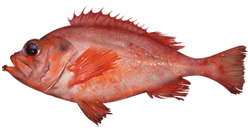
The Acadian redfish, also known as the Atlantic redfish, Acadian rockfish, or Labrador redfish, is a species of marine ray-finned fish belonging to the subfamily Sebastinae, the rockfishes, part of the family Scorpaenidae. It is native to the deep waters of the northwestern Atlantic.

Bellator militaris, the horned sea robin, is a species of marine ray-finned fish belonging to the family Triglidae, the sea robins. This fish is found in the western Atlantic Ocean.
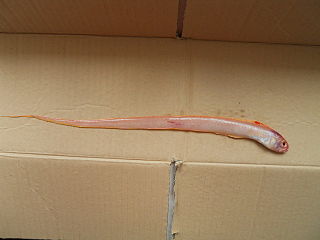
Cepola macrophthalma is a species of marine ray-finned fish belonging to the family Cepolidae, the bandfishes. It is found in the eastern Atlantic and Mediterranean from Senegal north to the British Isles. This species is known as the red bandfish, though this name is also given to other members of the genus Cepola.

Bellator is a genus of marine ray-finned fishes belonging to the family Triglidae, one of two genera belonging to the subfamily Prionotinae, the sea robins. These fishes are found in the Western Atlantic Ocean and eastern Pacific Ocean, in the waters off both North and South America.

Bellator egretta, the streamer searobin, is a species of marine ray-finned fish belonging to the family Triglidae, the sea robins. This fish is found in the western Atlantic Ocean.

Prionotus is a genus of marine ray-finned fishes belonging to the family Triglidae, one of two genera belonging to the subfamily Prionotinae, the searobins. These fishes are found in the Western Atlantic Ocean and eastern Pacific Ocean, in the waters off both North and South America.

The black scorpionfish, also known as the European scorpionfish or small-scaled scorpionfish, is a venomous scorpionfish, common in marine subtropical waters. It is widespread in the Eastern Atlantic Ocean from the British Isles to the Azores and Canary Islands, near the coasts of Morocco, in the Mediterranean Sea and the Black Sea.

Small red scorpionfish is a venomous Scorpionfish, common in marine subtropical waters. It is widespread in the Eastern Atlantic from the Bay of Biscay to Senegal, Madeira, Azores and the Canary Islands, including the Mediterranean and the Black Sea.

Platycephaloidei is a suborder of ray-finned fishes, part of the order Scorpaeniformes, and includes the flatheads, ghost flatheads and sea robins.

Scorpaenopsis diabolus, the false stonefish, false scorpionfish or the devil scorpionfish, is a species of venomous marine ray-finned fish belonging to the family Scorpaenidae, the scorpionfishes. It has venomous spines and lives in the tropical Indian and Pacific Oceans as well as in the Red Sea. It is a bottom-dwelling predator that relies on its camouflage to catch passing prey.
Prionotus evolans, the striped searobin, is a species of marine ray-finned fish belonging to the family Triglidae, the sea robins. This fish is found in the western Atlantic Ocean.
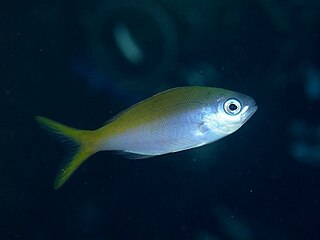
Paracaesio xanthura, the yellowtail blue snapper, the false fusilier, gold-backed fusilier, Pedley's fusilier or Southern fusilier, is a species of marine ray-finned fish, a snapper belonging to the family Lutjanidae. It is native to the Indo-Pacific region.

Etelis carbunculus, the deep-water red snapper, ruby snapper or longtail snapper, is a species of ray-finned fish, a snapper belonging to the family Lutjanidae. It is found in the Indo-Pacific region.
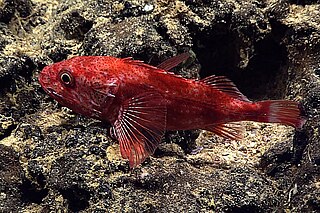
The channelled rockfish, also known as the deepwater scorpionfish, is a species of marine ray-finned fish, belonging to the subfamily Setarchinae, the deep-sea bristly scorpionfishes, part of the family Scorpaenidae. It has a wide distribution in tropical and subtropical oceans.

Scorpaenodes guamensis, the Guam scorpionfish or common scorpionfish, is a species of venomous, marine, ray-finned fish belonging to the family Scorpaenidae, the scorpionfishes. It has a wide Indo-Pacific distribution.
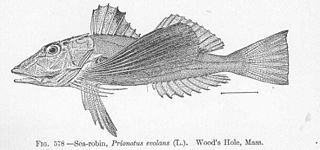
Prionotinae is a subfamily of demersal, marine ray-finned fishes, part of the family Triglidae. The fishes in this subfamily are called sea robins and are found in the Western Atlantic and Eastern Pacific Oceans, the other two Triglid subfamilies are called gurnards.


















